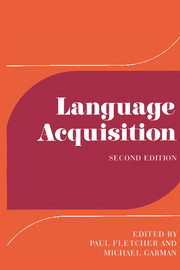Book contents
- Frontmatter
- Contents
- Contributors
- Preface
- Part I Contexts and determinants
- Part II The development of linguistic systems: phonology
- Part III The development of linguistic systems: grammar
- Introduction
- 13 Early vocabulary
- 14 Early syntax
- 15 Assessing morphological development
- 16 Personal pronouns
- 17 Tense and aspect
- 18 Modality
- 19 Deixis
- 20 A crosslinguistic perspective: morphology and syntax
- Part IV Later language development
- Notes to chapters
- Bibliography and citation index
- General index
- Titles in the series
18 - Modality
Published online by Cambridge University Press: 05 June 2012
- Frontmatter
- Contents
- Contributors
- Preface
- Part I Contexts and determinants
- Part II The development of linguistic systems: phonology
- Part III The development of linguistic systems: grammar
- Introduction
- 13 Early vocabulary
- 14 Early syntax
- 15 Assessing morphological development
- 16 Personal pronouns
- 17 Tense and aspect
- 18 Modality
- 19 Deixis
- 20 A crosslinguistic perspective: morphology and syntax
- Part IV Later language development
- Notes to chapters
- Bibliography and citation index
- General index
- Titles in the series
Summary
Modality as a language function
From a linguistic point of view, modality is a semantic category expressing concepts such as ‘possibility’, ‘necessity’, ‘obligation’, ‘permission’, ‘intention’ and so on. The most important formal devices found in languages for expressing modality are: (1) modal verbs, whether main verbs or auxiliaries, e.g. may, can, must, will; and (2) modal inflections, or moods, e.g. imperative, subjunctive, optative, conditional. In this chapter we shall limit ourselves to these forms, since they are the modal categories that have been most systematically studied in linguistics, and (except for intonation in the very early stages of language acquisition) they are the only ones to play a significant role in early child language. Other categories expressing modality, such as adjectives (e.g. possible, likely, certain), adverbs (e.g. possibly, perhaps, maybe), nouns (e.g. possibility, likelihood), derivational affixes (e.g. -able in controllable, governable), and verbs taking sentential complements (e.g. believe, doubt) are almost completely missing from early child language.
The function of modality is to enable the speaker either to qualify the propositions expressed by his sentences with respect to their validity, truth, or factuality (Flämig 1970:400; Lyons 1977: 797ff; Grundzüge 1981:521) or to indicate obligation and permission ‘of acts performed by morally responsible agents’ (Lyons 1977: 823) with reference to norms. These types of modality have been called epistemic and deontic, respectively.
- Type
- Chapter
- Information
- Language AcquisitionStudies in First Language Development, pp. 375 - 400Publisher: Cambridge University PressPrint publication year: 1986
- 34
- Cited by



